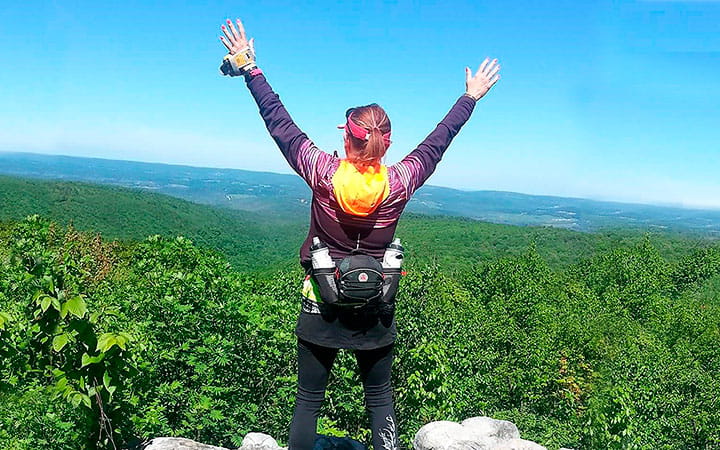Dealing with Extreme Pain
January 15, 2020

Seventeen years ago, a breast cancer diagnosis spurred Gale Connor to make some major healthful changes in her life.
One of the biggest was to become a runner – which she chose for its physical and emotional benefits. For eight years, she ran roads. Then she moved up to trails, enjoying the softer ground and surrounding trees, and then to ultra runs, some of which were up to 60 miles long.
“As a long-distance runner, I understand pain,” she says.
But last year, Gale’s left shoulder gave her the kind of pain that eclipsed everything else.
“I could barely stand it. I could not even sit at my desk for more than a few minutes without getting up for a walk,” she says.
Gale wasn’t certain what triggered it.
“It wasn’t from running, per se, but when you run long distances, you have to carry water and other supplies,” says Gale, who lives in Seven Hills and is a clinical research data analyst at UH Cleveland Medical Center. “That might have had something to do with it. Or it could have been just sitting at a desk for the past 10 years.”
Nothing Seemed to Help
Gale could not find relief. Not through physical therapy, not with over-the-counter drugs. None of her physicians suggested opioids, and she wouldn’t have asked, as such medication had made her ill in the past. “I tried many therapies, but nothing was working,” she says. “I was starting to consider that if it got worse, I might have to file for disability,” an idea she found disheartening.
Gale had seen chiropractors over the years for back and hip issues. “We runners are very familiar with working with chiropractors and using complementary medicine to try to fix our plethora of issues without medication,” she says. “But the general public is not as familiar – probably because most insurance either didn’t pay for it or gave very limited visits.”
So Gale wondered whether it could help with her shoulder pain, and soon after learned that UH Connor Integrative Health Network (CIHN) offered chiropractic care. (Her sharing the Connor name is pure coincidence.) She quickly made an appointment with David Vincent, DC, Medical Director, Chiropractic and Massage Therapy, at CIHN.
CIHN has been offering chiropractic care since 2018, when Dr. Vincent was hired. This health profession specializes in evaluation of the body’s structural, spinal and neurologic system and their effect on overall health. Research has shown that this drug-free approach can ease a number of neuromusculoskeletal conditions, including back pain, neck pain, headaches, sciatica and joint pain – including in the shoulders.
Treatment may include chiropractic manipulation or adjustments, muscular therapy, rehabilitative exercise and lifestyle counseling. At CIHN, the chiropractors blend a traditional hands-on approach with the science and technology of modern medicine and the power of physical rehabilitation techniques.
An Unexpected Diagnosis
In Gale’s case, Dr. Vincent diagnosed nerve pain. “I had no clue that’s what it was,” she says.
Then she began seeing chiropractor Sarah Prosak, DC regularly at UH Connor’s Rocky River location. Dr. Prosak even specializes in treating athletes, which further impressed Gale.
“For the first time in months, I got relief from the pain,” Gale says. “Even during the first visit. I wanted to cry – it was a complete game changer.”
Gale had seen chiropractors elsewhere in the past, “but they’ve always done the same type of treatment – take X-rays and do the exact same manipulation every time I saw them. Dr. Sarah does treatments that vary, depending on what my current problem and pain level is. She actually listens to me and works on my body accordingly. I’m still seeing her every week.”
And That’s Not All
Gale added acupuncture at CIHN as an adjunct treatment. Her shoulder pain is manageable now, and thoughts of a disability retirement have vanished.
“Sarah and Megan Quesada [LAc], who does my acupuncture, have saved not only my running life, but my professional life,” she says. “To anyone who is on the fence about these types of therapies, I’d say you should really try it.”
Tags: Pain, Integrative Medicine


